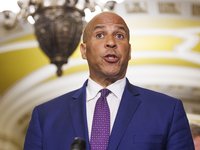A few weeks ago, Eagles starting left tackle Jason Peters said he wanted a new deal, on the premise that he didn't like having the uncertainty of his standing with the team every offseason. The following day, the Eagles obliged by giving Peters a one-year contract extension that served more-so as a restructure.
- MORE ON THE EAGLES
- A collection of hate mail from our dumpster fire series
- An updated look at the Eagles' depth chart
- Recap: Eagles chat with Jimmy Kempski
- Sources: Eagles LB Jordan Hicks injured hand while on honeymoon in Greece
The timeline of events would indicate that Peters spoke up, so he got a new deal. Maybe, but the deal certainly makes sense for both sides. It's not as if Peters bullied his way into a raise or something, though if there were a guy scary enough to accomplish that, it'd be him.
Way back in January, PhillyVoice identified Peters as a candidate to have his contract restructured as a way to free up immediate cap space while pushing the impact of his contract into future years. That's exactly what happened here.
Under Peters' old deal, he would have counted for $11,700,000 against the salary cap in 2017. Under the new deal, he now counts for $6,916,666, or an immediate savings of $4,783,334. According to OverTheCap.com, the Eagles now have a little more than $6 million under the salary cap in 2017, a figure that will grow whenever they release Ryan Mathews.
That added salary cap space will carry over into 2018 if it goes unused.
In 2018, Peters' cap number does not jump much at all. It goes from $11,250,000 to $11,666,666, a difference of only about $400K. The major difference between his old deal and his new deal in 2018 is that the Eagles will face a stiffer financial penalty if they release him. Under the old deal, the Eagles would only be on the hook for $1,000,000 in dead money if they cut him. On the new deal, they'll be on the hook for $6,333,334 in dead money if they cut him.
That is perhaps indicative that the Eagles project that Peters will be worth keeping around in 2018, however, even if he is not, the immediate savings of about $4.7 million will mostly offset the net loss of roughly $5.3 million (the difference in dead money from the old deal to the new deal) if they have to release him in 2018. Yes, I understand all of this can be confusing.
As we noted in our Eagles dumpster fire piece, Peters is old (he turns 36 in January). You already know, of course, but you may not realize exactly how old he is for someone playing his position. You have to go all the way back to 2001 to find a player older than Peters who started at least 10 games at left tackle in a season. That would be Lomas Brown, who started at LT for the Giants at the age of 38.
If Peters makes it to his third year of this deal in 2019, he'll be 37 at the start of the season, and will probably be playing guard by then. He will count for $10,666,668 in that third season. It'll cost the Eagles $2,666,668 in dead money to cut Peters at that time.
In short, looking just at 2017 and 2018, if Peters plays the next two years, the Eagles will have saved about $4.5 million against the cap. If they have to cut him next offseason because his play has sharply declined, it will be a net loss of roughly $500,000.
Follow Jimmy on Twitter: @JimmyKempski.
Like Jimmy on Facebook.
Like the new PhillyVoice Sports page on Facebook.






